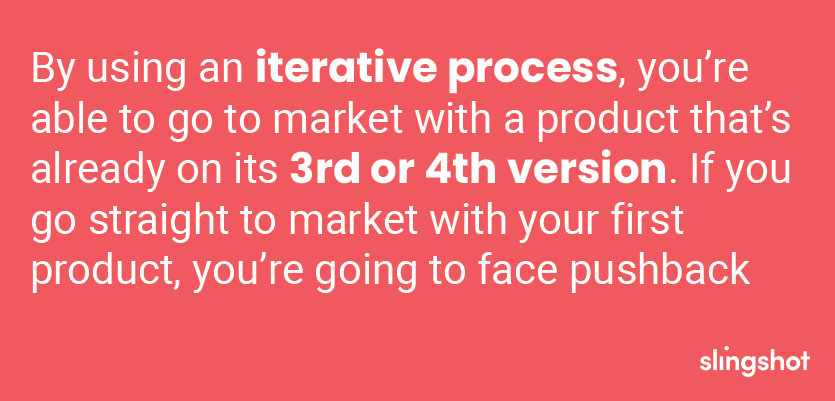We all want our project to be a success, right? I think we can say with certainty that no one enters a project expecting it to fail from the beginning (and if that is the case, you may want to reevaluate some things).
There are several things you can do before a project officially begins that can help ensure that you’re on the path to victory. One of those things is user testing, where you get a prototype of your product in the hand of users to get their feedback.
When user testing is brought up, there is sometimes push back: why would you want to spend time and money up front when you already know what you need? In our experience (all 17 years of it ?), we’ve seen quite the opposite: you don’t know for sure what users need until you test with them.
Today we’ll be walking through why user testing is important, how Slingshot conducts user testing, tips and tricks on how to be successful when testing, and what can happen if you skip user testing.
Summary
User Testing is done at the end of design and before development. Once your wireframes have been built out into a prototype, you’ll want to write up testing guides to follo while working with users. Repeat user testing as needed until you’re confident in your final design.
Some tips on how to conduct successful user testing are:
- Talk with people who will actually use the product
- Conduct testing individually to avoid group-think and distractions
- Don’t lead users to the answer; let them figure it out
- Remind your testers that there are no wrong answers
- Focus on the feedback rather than trying to sell them on the product
If you decide to skip user testing, you won’t be able to validate your product until after launch (when it’s the most expensive to update,) and that launch will be with the first iteration as opposed to the 3rd or 4th. Your product could be hard to use, causing users to avoid it at all costs.
But First, Numbers
It’s always fun for people like us (data nerds, business geeks, etc) to look at the statistics. Here are just a few quick numbers to put things in perspective:
228% |
50% |
$100 |
32% |
| The increase in ROI that companies with a human-centered design see vs the S&P 500. | The amount of post-launch time spent when rework is needed (which could’ve been avoided) | The average ROI for every dollar spent on UX design. That’s an increase of 9,900%! | The percentage of customers that would stop using a brand they love after a negative experience. |
Why is User Testing Important?
Feedback is always good when it comes to development, but why is User Testing so important?
The best results are tangible
By utilizing user testing, you’ll be able to have real data points and evidence to make decisions moving forward. Speaking of tangible, having a life-like product they can click through will make your results more realistic.
Iterations are key
Think back to the last super-important email you wrote. If you had sent the very first version, would you be happy? Chances are no. The same goes for development: by iterating within user testing, you’ll be able to roll out with version five instead of version one.
How easy is usability?
How do you know your product is easy to use? Are you sure you’ve found the best way to handle the problem? The only real way to find out is by utilizing user testing to see where users struggle and where they easily ‘get it.’
Related Article: User Testing Explainer Video
How does Slingshot Conduct User Testing?
If you’ve ever spoken with someone at Slingshot, you know our main goal is to always give the best recommendations. It would be against our values to hide what we do, so here’s how the big kids at Slingshot conduct user testing
Step one – From Wireframe to Prototype
Before we get to testing, we have to have something to test with. Within the design process, wireframes will be created. These are essentially simple blueprints for each screen to layout the interface. Once the plan is set, we then move into designing the clickable prototype. This allows us to create something as ‘real’ as possible while keeping costs much lower.
Step two – What am I doing, again?
You don’t want to walk into a user test without a game plan. Just like in user interviews, slingshot sets up testing guides to make sure we get through everything we need to. If you forget to test a certain aspect, you won’t have any data to support or oppose the feature.
Step three – Rinse and repeat
You don’t want this to be a ‘one-and-done’ situation. We follow an iterative process when it comes to user testing. That way, if we find out we’re on the wrong track, we can easily switch to the right one with little effort and test it again. In all our years of testing, we have never gotten through the first round of testing without at least some change. Imagine what would’ve happened if you had gone straight to market!

What are Some Tips and Tricks to be Successful in User Testing?
So you’re in the testing phase – now what? What are things you and your development team should keep in mind? Here are some tips and tricks Slingshot uses to ensure we get the best data.
Test with the right people
You need to get your product in the hands of people who will actually use it. If you’re developing something for consumers, you don’t just want your C-suite to test it. You need to find people that are facing the issue you’re trying to solve, and see if it works.
You also don’t just want your biggest fans. While positive answers are informative, you definitely are going to want constructive criticism too. Not to mention you’ll want a diverse audience that covers all ages, ethnicities, and diversity within your target audience.
Three is a crowd
You want to make sure you’re getting the most honest answers. While group testing can be cheaper and easier, 10+ people in a room testing together means you’re going to have group think. By doing one-on-one user testing, you’re able to get more realistic information. You can ensure there’s less distractions and hear their thought process.
What’s the right answer?
Now this one can be tricky: you don’t want to lead your users to the right answer in any way. This can lead to painfully awkward pauses, where the user tries to figure out what they’re supposed to do without instructions. However, by allowing for struggle during user testing, you’ll be able to find out how intuitive your design is. Your product won’t come with a tutorial; If a user can’t do it themselves without instruction, then there’s a problem that needs fixed.
Comfort is key
If a tester feels confused or stressed, they won’t be able to interact with the product in their typical way. Make sure your user is comfortable. Let them know that issues are on the product, not them. Reassure them there’s no one right way to do things. Keep the conversation casual; treat the meeting like a catch-up with an old friend. If your user is comfortable, they’ll be able to interact with the product like they would in the ‘real world.’
Focus Focus
Keep in mind that user testing is not a demonstration or sales presentation of your product. Focus on the answers and feedback you’re getting rather than trying to ‘sell’ them on the idea of your product. As we mentioned earlier, most of the time this means staying silent during the actual test. While this can lead to frustration, you need to make sure you’re getting the best answers you can.
What Happens When You Skip User Testing?
So we’ve talked about the positives of user testing; the rainbows and butterflies. We do have to take a negative turn here to discuss what can happen to your product if you decide to skip user testing.
Unable to validate
If you read our blog on Why You Need a Research Phase, we talked about how you can learn so much by conducting some up-front research. However, if you skip user testing, you’ll never be able to truly validate your findings. How do you know you have the right answer? The research may conclude that a feature is the right one, but no testing means you’ll have no feedback on the implementation before launch.
Usability problems
Earlier, we talked about how user testing can help you understand how easy your product is to use. Imagine if you took your designs straight to development; you have no evidence that your interface can be understood by your users.
First is the worst
Again, we mentioned earlier that by using an iterative process, you’re able to go to market with a product that’s already on its 3rd or 4th version. If you go straight to market with your first product, you’re going to face pushback. It’s like studying for a test: wouldn’t you rather complete the study guide than ‘wing it?’

Risky Business
With no evidence to support the choices you’ve made, you’re adding a lot of risk to your project that could’ve been avoided with user testing. Of course there’s no 100% guarantee a project will be successful, but you’re much more likely to be correct if you test before launch.
Money, Money, Money
This may be the biggest downside to skipping user testing: you’re going to lose a lot more money when you update after launch as opposed to in the design phase. If you use user testing to inform your design while it’s still in prototype form, you’ll be able to simplify your complexity, spend less money on unnecessary features, and save your app from being changed in its more vulnerable state.
Conclusion
Success of a tech project comes from validating your approach and basing your decisions on evidence. User testing allows you to get real feedback from real users before there’s any real issues. That’s really cool.
User testing is important because it allows you to make changes cheaper and faster based on your users. There are several ways you can ensure that your testing is getting you the best result, like making testers comfortable and not leading them to the answer you want To hear.
Skipping user testing means your product is less likely to solve the problem and be easy to use, while being more likely to cost a lot of money to fix down the road.
So here’s to your awkward conversations with testers; may the silence and frustration lead you to victory!




